 According to statistics, there are now more than 500,000 Ordinal inscriptions on the Bitcoin blockchain as the trend continues to gain significant traction. Onchain data also shows that since inscriptions started gaining popularity last month, Bitcoin miners have obtained 98 bitcoins worth $2.66 million in added fees. The Rise of Ordinal Inscriptions on Bitcoin Blockchain […]
According to statistics, there are now more than 500,000 Ordinal inscriptions on the Bitcoin blockchain as the trend continues to gain significant traction. Onchain data also shows that since inscriptions started gaining popularity last month, Bitcoin miners have obtained 98 bitcoins worth $2.66 million in added fees. The Rise of Ordinal Inscriptions on Bitcoin Blockchain […]We’re thrilled to announce that we have added seven new NFT collections to Kraken NFT for our clients to explore, collect and trade. After revealing dozens of NFT collections over the past few weeks, we carefully selected these new collections so you can continue to…
The post Adam Bomb Squad, Texture Punx Official, CHRYSALISM: DNA, The Captainz and more collections added to Kraken NFT appeared first on Kraken Blog.
 U.S. tech giant Meta is giving up on operations with non-fungible tokens (NFTs) amid ongoing turbulence in the crypto space. The company allowed creators to share digital collectibles on its leading social media platforms last year. Meta Platforms Cutting Off Support for Non-Fungible Tokens California-based technology conglomerate Meta is winding down support for digital collectibles […]
U.S. tech giant Meta is giving up on operations with non-fungible tokens (NFTs) amid ongoing turbulence in the crypto space. The company allowed creators to share digital collectibles on its leading social media platforms last year. Meta Platforms Cutting Off Support for Non-Fungible Tokens California-based technology conglomerate Meta is winding down support for digital collectibles […]
NFT application endures demanding fees on the Apple App store for the convenience of iOS payments and a broad user base.
Apple’s continued enforcement of in-app purchases to sell services remains a trade-off for NFT applications looking to tap into the convenience of streamlined in-app purchases for iPhone users and a massive user base around the world.
As previously reported, Apple maintains strict rules for nonfungible token (NFT) apps, enforcing a 30% commission on the sale of NFTs through in-app purchases.
The enforcement of this 30% commission has been a sore point, with Coinbase Wallet seeing an update to its application blocked by Apple in December 2022. This was due to Apple suspending the latest app release until Coinbase Wallet disabled the ability to send NFTs through the application.
Apple may have to permit third-party app stores on its devices by 2024 in the European Union in response to the recently drawn up Digital Markets Act. This is expected to allow developers to install alternative payment systems within non-Apple apps, but would not apply to countries outside of the EU.
Related: ‘Grotesquely overpriced’ — Apple’s App Store wants 30% cut on NFT sales
Cointelegraph reached out to Nodle CEO Micha Anthenor Benoliel to unpack the implications for NFT apps that continue to operate through the Apple Store. Nodle’s app rewards users for participating as nodes in a proprietary decentralized IoT network, in addition to allowing users to mint NFTs from their smartphones.
Benoliel notes that Apple has clear guidelines enforcing NFT apps to use the in-app purchase to sell any services similar to minting of an NFT, in an effort to prevent users from purchasing NFTs from mobile applications outside of the Apple App store and its in-app purchase function:
“It may take some time for them to fully grasp the implications of Web3 principles, but for now, it looks like they are trying to safeguard their business and customers by enforcing these guidelines.”
This is in clear contrast to Android, where app developers have freedom to experiment and are not boxed into using the Play Store in-app purchase mechanism to mint or sell NFTs. Nevertheless Benoliel believes there are a myriad of benefits that balance out the trade-off of Apple’s current terms and conditions.
He notes that iOS holds a commanding position in the U.S. mobile market, while its in-app purchase functionality removes payment friction for iPhone users:
“The company has gone to great lengths to simplify the purchasing process and make it easier for developers to support transactions without managing sensitive credit card information.”
The App Store also provides a centralized service that handles various currencies and exchange rates that developers would have to manage when implementing a credit card payment solution.
Related: Robinhood Wallet rolls out on iOS with Android support to follow
Nodle intends to provide infrastructure to creators to enable app users to mint unique creations. In order to provide this service to iOS users under Apple’s current conditions, the platform has had to shift costs towards its users:
“There's a catch. Apple charges up to 30% of the sale price for minting an NFT. Nodle includes this fee in its customer-facing price.”
Nodle’s NFT minting process allows a user to make use of camera photos or images from their galleries before paying for minting costs using Apple’s in-app purchase. The ‘Minting as a Service’ component features a centralized service that receives and checks images before minting the NFT using the Polkadot NFT pallet upon payment confirmation.

Benoliel told Cointelegraph that Apple could benefit in the long run from the free exchange and trading of NFTs in apps, which could incentivize users to opt for alternative solutions:
“When you read about incoming EU laws that will force Apple to permit alternative app stores and apps without the need to go through its App Store, one can wonder if this could not happen soon in the US as well.”
Up until that point, Benoliel believes that there is still a valid argument for NFT app developers to consider supporting iOS, citing the in-app purchase feature’s convenience for transactions. A massive user base also presents a ‘valuable opportunity’ for developers to reach a broad audience of potential users.
Cryptocurrency wallet applications are also grappling with specific requirements to launch on the Apple App store. Decentralized exchange Uniswap intended to launch its iOS app in December 2022 but has not been given the go-ahead by Apple.

NFT rarity is the uniqueness and scarcity of a nonfungible token, calculated using factors, such as distinguishing features and demand.
An NFT’s rarity plays a role in its perceived cultural and artistic significance. For example, an nonfungible token (NFT) that is the only one of its kind and possesses significant cultural or historical value may be considered a rare and must-have artifact. But why is NFT rarity important?
NFT rarity is important because the market worth and appeal of an NFT can be significantly influenced by the nonfungible token’s rarity, which can also influence its resale value. Moreover, NFT collectors frequently look for unusual and distinctive nonfungible tokens to add to their collections.
Nonetheless, it is crucial to remember that an NFT’s worth or relevance is not necessarily determined by its rarity alone. Other elements that may affect the value and appeal of nonfungible tokens to collectors include the caliber of the artwork, the reputation of the artist and the cultural or historical relevance of the piece.
This article will discuss the concept of NFT rarity, what determines NFT rarity and common techniques for calculating NFT rarity rankings.
NFT rarity refers to the uniqueness or scarcity of a particular nonfungible token in a collection. The overall number of nonfungible tokens in a collection, the number of copies of a certain nonfungible token in a collection and the unique qualities or traits of a particular NFT are all factors that affect nonfungible token rarity.
For instance, certain NFT collections could contain a small total number of NFTs, which can increase the rarity of each nonfungible token in a given collection. Some collections might have a lot of NFTs, but a specific nonfungible token might be uncommon because it has distinctive qualities, such as a particular color scheme, animation or sound effect.

The value of NFT collectibles can be significantly impacted by its rarity. Due to their increased value and demand from collectors, the price of rare NFTs may rise on NFT marketplaces. Some NFT projects have even created algorithms to figure out the rarity of specific NFTs within a collection, which can provide buyers and sellers with more knowledge when figuring out the worth of an NFT.
An NFT rarity checker is a tool or service that allows users to assess the rarity of a nonfungible token, whose value is frequently based on its scarcity, rarity and uniqueness.
To determine an NFT’s rarity, nonfungible token rarity calculators examine a variety of features of the nonfungible token, including its properties, metadata and characteristics. An NFT rarity checker, for instance, might evaluate the color scheme, pixel density or other visual characteristics of an nonfungible token image to ascertain its rarity.
As an alternative, an NFT rarity checker might assess the demand for a certain nonfungible token or the quantity of copies of that NFT that are currently on the blockchain to determine how rare it is.
Here are some common steps that an NFT rarity calculator may follow to determine the rarity of a nonfungible token:
However, the rarity and value of an NFT can also be influenced by other factors, such as the present market conditions and buyer and seller sentiments, so it is crucial to keep in mind that these calculators are not ideal.
Related: How to add unlockable content to your NFT collection
Determining NFT rarity can involve various factors depending on the specific nonfungible token and the attributes that it possesses. One of the key elements that can indicate an NFT’s uniqueness is its scarcity. NFT collections are more likely to be rare and valuable if there are fewer copies of them than if there are many. By counting all of the copies of a nonfungible token that are present on the blockchain, it is possible to estimate its rarity.
Nonfungible tokens can have a number of characteristics that contribute to their rarity. An NFT might, for instance, stand out due to its distinct color scheme, an uncommon combination of characteristics or a particular theme or subject matter. These characteristics can be examined and compared to those of other nonfungible tokens in the same category to determine how rare an NFT is.
Popularity and demand can also affect NFT rarity. That said, NFT collections are more likely to be rare and expensive if there is a great demand for them. Sales information, social media mentions and other popularity indicators can be used to determine this.
An NFT’s history or provenance may have an effect on its rarity. A nonfungible token may be rarer and more expensive than other NFTs if it has a distinctive past, such as having once belonged to a celebrity or being featured in a well-known meme.
Depending on the particular NFT collectibles, the number of editions or copies that exist within that collection and the demand for that particular NFT within the marketplace, there are numerous approaches to generating nonfungible token rarity rankings.
Typically, the formula involves giving each quality or trait a numerical value before summing them to determine the rarity score. However, depending on the NFT platform or market, the precise formula may change. To calculate rarity scores, some platforms may also use external data sources or machine learning algorithms.

For instance, platforms, such as Rarity.tools and Nansen employ algorithms to examine the characteristics and properties of each NFT contained in a collection and calculate the rarity score.
In general, here are a few common techniques to determine NFT rarity rankings:
Related: NFT investment: A beginner’s guide to the risks and returns of NFTs
Do you wonder what a good NFT score is or if a high rarity score means the scarcest nonfungible token? The answer is that there is no one-size-fits-all approach to what constitutes a “good” NFT rarity score, as the score will depend on a variety of factors, such as the specific nonfungible token collection, the attributes or traits being measured and the prevailing market conditions.
Furthermore, even if a high rarity score can be seen favorably for an NFT, rarity scores are frequently arbitrary and susceptible to a variety of influences, as mentioned above. Additionally, a high rarity score does not always imply a significant value or resale price because other elements, such as the fame of the artist and the cultural or historical relevance of the nonfungible token, might also come into play.
As a result, while a high rarity score might be a reliable indicator of a nonfungible token’s value and originality, it is essential to take other aspects into account when determining the value of a nonfungible token.

Nissan has recently filed four new Web3 trademarks for its Infiniti, Nismo and Nissan brands.
Japanese automotive brand Nissan has become the latest car manufacturer to ramp up its Web3 efforts, filing four new Web3-related trademarks filed in the United States, while its Japan unit is experimenting with auto sales in the metaverse.
According to Nissan’s Mar. 7 trademark applications to the United States Patent and Trademark Office (USPTO), the new filings cover its Infiniti, Nismo and Nissan brands.
#NISSAN has filed 4 trademark applications for
— Mike Kondoudis (@KondoudisLaw) March 13, 2023
▶️ INFINITI
▶️ NISMO
▶️ NISSAN
The filings signal plans for
Virtual Clothes + Cars
Stores for Virtual Goods + NFTs
NFT Marketplaces + Trading + Minting
Metaverse Advertising Services#NFT #NFTCommunity #Metaverse #Web3 #Car pic.twitter.com/iG3ZVgyD5t
The filings to the USPTO reveal Nissan's plans to create virtual clothes, cars, headgear, trading cards, toys, tickets, and an NFT marketplace for trading and minting NFTs.
The company has also outlined plans for metaverse advertising services and other "entertainment services" covering online video, images, artwork, tickets, audio, sounds, music, and trading cards, along with a website that has information on everything about Nissan’s proposed NFTs and how they will work.
There are also intentions for "non-downloadable computer software for use as a digital wallet," according to the filing.
Last week on Mar. 8, Nissan Japan announced it is conducting a three-month "demonstration experiment" of its virtual store "Nissan Hype Lab" to "study, consult, test drive, and purchase Nissan vehicles," while in the metaverse.

"At the same time we will examine the possibility of new sales methods for cars," it wrote in a statement.
The trial, which runs from Mar. 8 to Jun. 30, will allow customers to visit the virtual storefront "24 hours a day" via a PC or smartphone. Customers can create their own customized avatars and between certain hours, can even interact with virtual sales staff.

Customers can make an order for the car and finalize purchase contracts through this virtual sales office, according to the announcement.

Nissan also previously filed five trademark applications in October 2022 for some of its more prominent car models, including SKYLINE, Z, and GTR.
At the time, trademark attorney Mike Kondoudis said the car brand's filings signaled plans for NFT-backed media, online NFT marketplaces, digital wallets, NFT minting, trading and storing software.
Related: Keep an eye out for major company NFT trademark filings this year
Automotive giant General Motors has also been very active with NFT-related filings, with its latest trademark applications on Feb. 16 covering its Chevrolet and Cadillac brands.
American car manufacturer Ford Motor Company, prepped its entry into the world of NFTs and the Metaverse last September, filing 19 trademark applications across its major car brands.
Despite the ongoing crypto winter and bear market, multinational corporations are still pushing forward with trademark applications covering Web3, crypto, nonfungible tokens (NFTs), and the Metaverse.
Kondoudis said that there were record numbers of trademark applications for NFTs, Metaverse and crypto-related products in 2022.
We are excited to announce Kraken’s NFTournament! In celebration of the NCAA men’s and women’s basketball tournaments, Kraken is hosting a series of six competitions that coincide with each round of the real event. The competition will culminate in an epic championship round where one…
The post Compete in Kraken’s NFTournament for the chance to win $50,000 in prizes! appeared first on Kraken Blog.
 Yuga Labs, the creators of the blue-chip non-fungible token (NFT) collection Bored Ape Yacht Club (BAYC), announced that the team has completed its Ordinal Inscription auction with a total of 3,246 bidders. The Twelvefold collection of inscriptions generated 735.7 bitcoin, worth more than $16 million. The highest bid was 7.1159 bitcoin, equivalent to $160,000. Individuals […]
Yuga Labs, the creators of the blue-chip non-fungible token (NFT) collection Bored Ape Yacht Club (BAYC), announced that the team has completed its Ordinal Inscription auction with a total of 3,246 bidders. The Twelvefold collection of inscriptions generated 735.7 bitcoin, worth more than $16 million. The highest bid was 7.1159 bitcoin, equivalent to $160,000. Individuals […]
The highest of the 288 bidders forked out just over 7 BTC for one of the 288 Bitcoin Ordinals-based NFTs up for auction.
The auction for Yuga Labs’ inaugural Bitcoin Ordinal nonfungible token (NFT) collection has ended, netting the firm $16.5 million in just 24 hours.
A total of 288 bidders won one of the Bitcoin NFTs from the “TwelveFold” collection. Yuga said the winners will receive their inscription within one week, while the unsuccessful bids will have their bid amount returned within 24 hours.
The TwelveFold auction has ended. Congratulations to the top 288 bidders - you will receive your inscription within one week. Valid bids that did not rank in the top 288 will have their bid amount returned to their receiving address within 24 hours.
— Yuga Labs (@yugalabs) March 6, 2023
The auction yielded 735 BTC worth an estimated $16.5 million at current prices. The highest of the 288 bidders paid just over 7 BTC or $161,000 for one of the pieces.


Yuga announced the collection in late February, describing it as a “base 12 art system localized around a 12×12 grid, a visual allegory for the cartography of data on the Bitcoin blockchain.”

It comprises a limited edition collection of 300 generative pieces inscribed on Satoshis on the BTC network. The lucky winners were eager to share their new NFTs online:
I was lucky enough to place a winning bid for a @yugalabs #Twelvefold #BTC ordinal. Can’t wait to see how this ages in the decades to come. Won’t ever catch me fading #yuga. Also… Massive props to @nftsupply for the help setting up a wallet etc. He’s a huge resource for us all. pic.twitter.com/g8fSDIfhzX
— Carsonturner.eth ATL (@carsonturner) March 6, 2023
Related: Nifty News: Yuga Labs jumps on Ordinals hype
As reported by Cointelegraph, Yuga Labs received backlash over the weekend from the crypto community who identified flaws in how it conducted the auction for the Ordinals collection.
 On March 4, the decentralized exchange Pancakeswap announced that the team plans to launch its version three (v3) iteration of the platform during the first week of April 2023. Pancakeswap v3 will provide new features and improve liquidity alongside enhancements in interface accessibility and the decentralized exchange (dex) platform’s yield farming experience. Pancakeswap Announces Version […]
On March 4, the decentralized exchange Pancakeswap announced that the team plans to launch its version three (v3) iteration of the platform during the first week of April 2023. Pancakeswap v3 will provide new features and improve liquidity alongside enhancements in interface accessibility and the decentralized exchange (dex) platform’s yield farming experience. Pancakeswap Announces Version […]